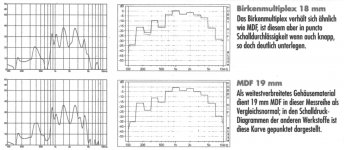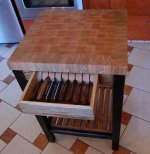We've played with that stuff and did not come to the same conslusion.
dave
wd love to know why
apart from the weight, solid-surface offers many advantages over mdf; I recommended a friend use (thermoformed)corian for his monitor build and the results were excellent
if you are going to use it a butcher block is much less likely to give you problems
Butcher block construction would probably be ideal. As the width of a solid piece of wood increases so does the chances of cracking. Glue many 2" wide pieces of wood together and the glue joints in between the wood will give a little bit and reduce the chance of cracks.
Butcher block is strips of wood glued together - this is not much different from a solid piece, as far as expansion and contraction go. If they are the same species of wood, both will expand and contract equally.
Laminated lumbers (butcher block) real advantage is warp and twist resistance - it will stay flatter. Oh and it uses up a lot of scrap wood that is pretty much useless for anything else.
Butcher block is strips of wood glued together - this is not much different from a solid piece, as far as expansion and contraction go. If they are the same species of wood, both will expand and contract equally.
Laminated lumbers (butcher block) real advantage is warp and twist resistance - it will stay flatter. Oh and it uses up a lot of scrap wood that is pretty much useless for anything else.
This is a good point. And as I reflect on it, even 2" strips of solid wood edge glued didn't prevent cracking entirely. Any attempt to engineer floating panels into the basic box would probably not be air tight. This is acceptable for furniture making, but not speakers.
And brings up another important point. You can start off with a perfectly flat piece of solid wood and if you leave it in a garage over the summer within a few months it will start to warp.
I think I've read about products claiming to stabilize wood by penetrating into the pores. These products talk about having to soak the wood for an hour per inch of board.
I aso wonder if coating all faces of the wood with polyurethane would provide enough moisture barrier to prevent splitting. I've always thought it was more the humidity changes than temperature changes that caused splitting.
I have a friend who attempted to use solid woods in his speakers. They would be fine until winter came. In the summer he'd run air conditioning if the temp got above 80 degress and run heat in the fall and winter to keep the apartment to 68 degrees. The temperature swing couldn't have been more than 12 degrees year wide.
I aso wonder if coating all faces of the wood with polyurethane would provide enough moisture barrier to prevent splitting. I've always thought it was more the humidity changes than temperature changes that caused splitting.
I have a friend who attempted to use solid woods in his speakers. They would be fine until winter came. In the summer he'd run air conditioning if the temp got above 80 degress and run heat in the fall and winter to keep the apartment to 68 degrees. The temperature swing couldn't have been more than 12 degrees year wide.
Humidity is the killer. Winter is much drier than summer and wood will lose moisture to the air. In summer it absorbs moisture. This is seasonal expansion and contraction.
Sealing the wood does go a long way to minimizing this problem but no sealer is 100% impervious. The best strategy for using solid wood is to select properly dried stock, let is acclimate to the area where it will be used and seal as much of it as possible (inside and out). Design to allow for this seasonal movement (this is very difficult with speakers).
I've seen some recent comments about air drying being better than kiln drying - this is pretty much false, unless whoever is using the kiln dries the wood too rapidly. This is easy to see - the ends of the boards are split ('checked'). Air drying just takes longer.
Last edited:
"Winter is much drier than summer…"
That might be the case in Canada, over here it is the other way around.
In fact the last few years it was damp all year 'round except the two weeks of Wimbledon in June. The rest of the time and especially in winter it tends to rain… a lot!
That might be the case in Canada, over here it is the other way around.
In fact the last few years it was damp all year 'round except the two weeks of Wimbledon in June. The rest of the time and especially in winter it tends to rain… a lot!
Not trying to be too picky here but to make sure you guys are identifying the same things: Butcher blocks (good ones) are end grain. End grain is used as it feels good, sounds good and doesn't dull your knife as quickly.
Laminated cutting boards (good ones) are edge grain and cheap ones are off-edge or flat grain.
This is assuming we are talking standard hardwoods like Maple and not bamboo.
Laminated cutting boards (good ones) are edge grain and cheap ones are off-edge or flat grain.
This is assuming we are talking standard hardwoods like Maple and not bamboo.
... and especially in winter it tends to rain… a lot!
Ok, wet season and wetter season...better?
Ok, wet season and wetter season...better?
I think 'warm wet season' and 'cold wet season' would really hit the nail.
Is the resonaance actually that audiable even for full range (multi way, I meant to put this there!). Is there a great amount of difference?
Simply, no. The material used for constructing the enclosure is one of many factors. The way you are using it, the construction of the box itself, bracing, damping of the walls is very important. Properly build box from solid wood can definitely be better than average MDF construction. In my humble opinion if you design and build the box very well, the differences will be under your recognition.
Is the resonaance actually that audiable even for full range...
Yes. The surfaces are large compared to the drivers.
'It is a well established fact that MDF and particle board loudspeaker boxes resonate in conjunction with the woofer and radiate nearly as much sound pressure as the driver itself at certain frequencies.' - Vance Dickason, Loudspeaker Design Cookbook, 4th. Ed, P79.
Is there a great amount of difference?
Bracing and wall damping are probably more important than the absolute choice of material, but the choice of material has a significant effect and should be taken into account when planning a design. The general approach is to both damp the vibration and shift the resonant frequencies higher where they are more amenable to damping with specialist materials such as are used in cars.
w
The general approach is to both damp the vibration and shift the resonant frequencies higher where they are more amenable to damping with specialist materials such as are used in cars.
Note that the kind of damping here, reduces the resonant frequency, The prime reason for raising resonances is that the higher they are the less likely they are to be excited.
With energy to excite at least decreasing by the square of the frequency, and with some assumptions arguably decreasing by the 4th power of frequency, raising panel resonant frequency is a pretty powerful tool.
Personally i don't use extra panel damping.
dave
Losing energy is your friend, odd numbers are even better!
You lose energy every time when it transfers from one medium to another - wood to glue to wood to glue soaks resonances.
And panels that aren´t 2:1 or suchlike...design odd, it´s better.
Yes ! That´s why i ended up with a sandwitch contruction consisting of four layers of materials of different density.
- Status
- This old topic is closed. If you want to reopen this topic, contact a moderator using the "Report Post" button.
- Home
- Loudspeakers
- Subwoofers
- What is the best wood for speaker enclosures?

